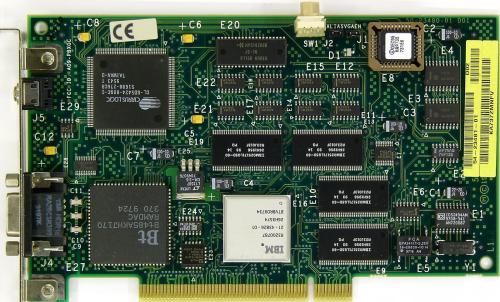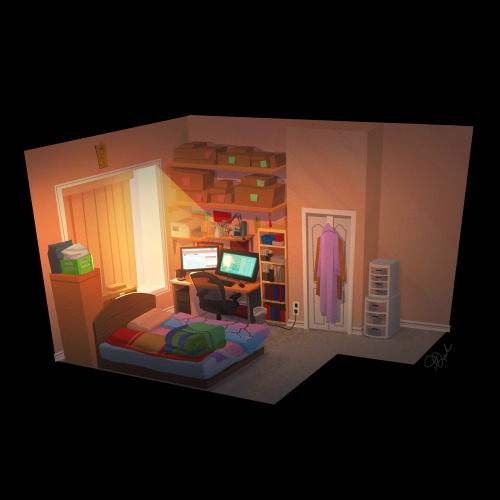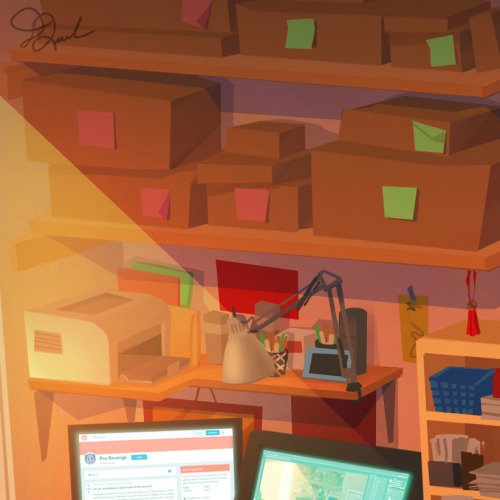#workstation
“Amateurs sit and wait for inspiration, the rest of us just get up and go to work.”
― Stephen King
Post link

Trying journaling for the first time, digital or otherwise! I’m following ’@shethespy’ on Instagram for prompts. This is my Day 1 entry for July mood board!
#july #journal #digitaljournal #moodboard #julymoodboard #pastels #workstation #quote #outfit #cottage #hike #lake #wine #pinksky #sky #pancakes #explore #history
It has potential. Still unpacking.
#workstation #musicstudio #letsjam (at Boyle Heights, Los Angeles)
https://www.instagram.com/p/BonjtpHhKCo/?utm_source=ig_tumblr_share&igshid=1tq40kx7ymnex
Post link
DEC PowerStorm 3D30 / TGA2 (March 1996)
PowerStorm 3D30 was an early low-cost 3D accelerator from Digital/Compaq. It cost just $795 and offered up to 1280x1024 in 256 colors (this was the maximum for all resolutions). Most of you presumably don’t know the card, because you could not find it in a standard PC. It was designed for DEC’s workstation based on Alpha CPUs. There is very little info about it (often not even correct) so I decided to consolidate all I know about it. This is what I know and what I was able to measure on a real hardware (thanks to Kyle Fox):
Basic description
The card uses the standard 32-bit PCI interface and contains three big chips. Cirrus Logic CL-GD5424 is an SVGA chipset and has its own 256kB of memory (16-bit). Its purpose is just to provide VGA compatibility during boot, before a graphic driver is loaded by the OS. There is even a switch on the card that can disable it (for multi-monitor solutions with multiple cards).
The Bt485A chip is a 170MHz true-color RAMDAC that has a standard input pixel port together with a separate VGA input port. Thus, it allows a cheap way to connect both graphics chips to a single monitor output and switch between them.
The main chip (“TGA2”) is the silver one manufactured by IBM (and designed by DEC). It’s a graphics controller with support for 2D, 3D and limited video acceleration. In this particular card (3D30), it has only 2MB of video memory, which cripples the maximum color depth to just 256 colors (PowerStorm 4D20 with the same chip supports also 12-bit and 24-bit modes).
In 2D/video, it offers standard BitBLT operations, YUV-RGB conversion and a very primitive 1-D video scaling with filtering (yes, hardware does the job only on horizontal axis; vertical scaling is handled by the CPU). There is no support for multiple 256-color palettes, which means that the video is converted to colors available for the whole desktop.
3D acceleration
The chip supports following features in hardware:
- Double-buffering (contrary to SGI, the back buffer is stored in off-screen memory and copied once the frame is complete)
- Z-Buffer (including the necessary depth operations)
- Line and polygon drawing (wireframe, solid, smooth-shaded) … contrary to several sources the chip is not limited to just wireframe drawing
- Color dithering for 8-bit and 12-bit color modes
- Fast color interpolation (for Gouraud shading)
Thus, there is no support for alpha-blending (transparency effects), fog and textures. Don’t expect playing GLQuake-like OpenGL games on this. The chip’s targets are 3D modeling/simulation and CAD/CAE.
DEC decided not to integrate geometry unit (transform & lighting) known from hi-end professional cards of the era and let the powerful Alpha CPU do the job.
We have tested the card under Windows NT 4.0 using our GPUbench program running under FX!32 emulation (fortunately, most of the tests generate very little CPU load so this doesn’t affect the results and the graphics driver runs as native code). This is one of very few cards being able to accelerate 3D in 256 colors with Windows.
The driver is limited to OpenGL 1.0.1 with extensions for vertex arrays. Unlike NT4 drivers for Matrox Millennium I/II and ATI Rage II cards, this driver is full ICD (installable client driver) so it handles the whole rendering pipeline. Early ATI and Matrox cards used MCD (Mini-Client Driver), which is basically a modification of the Microsoft’s OpenGL software renderer, where you can accelerate just the features available by the card (for example only untextured polygons). The issue with MCD is that you cannot accelerate the geometry processing. On the other side, MCD allows you to use even the features that are not supported by the card. DEC’s ICD driver completely ignores textures and does software emulation only for alpha-blending.
Having OpenGL acceleration in 256 colors brings color palette issues. The driver expects RGB 332 palette by default and if the application doesn’t handle this, colors will be wrong (OpenGL applications often didn’t care as they assumed at least 16-bit colors).
Performance
- Rasterisation speed is surprisingly good with 69 Mpix/s (millions of pixels per second) with smooth-shaded (untextured) polygons. This decreases to 38 Mpix/s when Z-Buffer is enabled. This allows the card to render 60 fps in 640x480.
For comparison with other cards (with enabled Z-Buffer): 50-MHz S3 Virge = 24 Mpix/s and 48MHz ATI Rage II+ = 21 Mpix/s, Matrox Millennium = 32 Mpix/s, SGI O2 = 56 Mpix/s, SGI Indy XL/XGE = 9 Mpix/s, SGI I2 Maximum Impact = 240 Mpix/s - Geometry pipeline can handle up to 606,000 vertices/second (516,000 with Z-Buffer) in a form of triangle strips or 329,000 independent triangles/second (291,000 with Z-Buffer).
This is about 30-50% of UNIX hi-end and about 80% of PC workstation hi-end. Geometry performance is comparable with SGI O2(300MHz MIPS R5200 with vector units; 1998). Consumer cards in a Pentium MMX 200MHz PC could handle no more than 100,000-200,000 vertices/second and 40,000-70,000 independent triangles/s (with enabled Z-Buffer) - Alpha-blending done in software causes significant performance drops to just 1.4 Mpix/s. If it’s possible, it is better to avoid this feature and use stipple alpha instead.
Verdict
It seems that this was a good low-cost choice for powerful universal technical workstations. Geometry performance was especially good thanks to the power of Alpha CPUs, which made it a better choice over SGI’s low-end (Indy), until SGI O2 was released later that year. O2 was better was heavy 3D applications, but didn’t offer that good CPU performance.
Even with the Alpha-based workstations (like the Digital Personal Workstation 500a we used for this testing), there were other options for 3D acceleration. You could buy the same graphics chipset with 16MB ($2,495) to get full true color (32-bit or 12-bit for fast double-buffering) or go even higher for DEC’s rebranded Intergraph solutions (RealiZm Z13 with support for textures; $8,000).
In the low-end, Matrox Millennium I (MGA-2064) was a supported 3D accelerator. It offered better color precision (up to 32-bit in 3D) and 30-40% worse geometry performance.
Additional resources: Full GPUbench results,Open3D release notes,Video capabilities of TGA2 in Digital Technical Journal,Infoworld
Post link
Replacing a dead CMOS battery in a Dallas NVRAM/clock chip without using proper tools. This was for our precious Silicon Graphics Inc. Indy UNIX workstation.
Post link
Playing with TIGA #1
This is my new project for next few months – SPEA Graphiti HiLite 1024 - a TI TMS34020-based professional CAD card (“TIGA”). The video output does not work properly as some traces between the GPU and RAMDAC are bad, but the rest of the card seems to be ok. Once I fix it, I would like to play with the chip and program some benchmarks to see the real performance. It looks like TIGA cards are valuable among collectors, but there is very little info about what can be done with them. TMS340x0 chips are fully programable 32-bit integer CPUs and this (rather low-end) card has 1MB of program/data memory (in addition to 1MB of framebuffer memory). It is like a complete computer on a card.
These chips were used in the graphics subsystem of Sun 386i UNIX workstation and some CRT terminals (like DEC VT1000). There were even Amiga Zorro cards with these chips (boosted with TI floating point co-processors), but presumably the concept was too complicated at the time when most people cared just about BitBlt and basic acceleration of line drawing.
(fortunately, my Siemens Nixdorf PCD-4Lsx PC is just big enough to accommodate one full-size ISA AT card… the card is very picky and refuses to work on Pentium systems or anything with ISA clock beyond ~8MHz)
Post link
I painted my work station/bedroom just for kicks - it looks worse in person haha.
Yes, I lurk Reddit too much.
Post link
Getting “The Last Of Us” vibes today…
.
.
.
#thelastofus #playstation #playstation4 #music #workstation #mood
https://www.instagram.com/p/BvAU3DRBvPy/?utm_source=ig_tumblr_share&igshid=1ns44xqksuvol
Post link





















